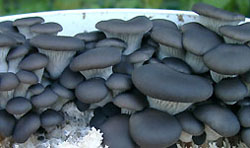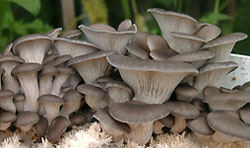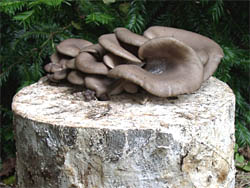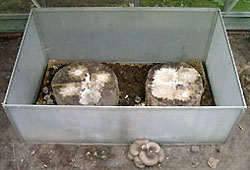

Photo above compared to photo below: Growth within two days
The oyster mushroom is native to central Europe. It grows higher up on dead deciduous trees but also grows on stumps. Oyster mushrooms grow in thick bunches or clusters. The mushroom spawn that we sell is a so-called all year round variety, Pleurotus ostreatus, i.e.
fruting bodies (mushrooms) can grow from the Spring to the Autumn. With higher ambient temperatures, the most important thing for mushroom growth is enough moisture for the logs.
The two photos on the left show the same greenhouse culture two days apart (growing in a flower pot, straw pellets with grain spawn). The colour of the fruiting bodies is initially dark grey or dark brown but they get lighter when they are ready to harvest and change to light brown or light grey.
It is normally very easy to grow oyster mushrooms because the mycelia is very robust and grows fast. When you take the logs out of the log pile they should be covered with white mycelia and have a quite aromatic smell (of mushrooms but also of mint).
The best wood to use is beech, poplar, willow, birch, ash, alder or even healthy wood from fruit trees. The logs should have a diameter of min. 18 cm to max. 40 cm. Oak is less suitable. You can also inoculate tree stumps with this mushroom. After felling a tree, you can inoculate the stump or roots which remain in the ground. The pre-requirement is that the tree was healthy and the stump is not situated in strong sunlight (you could build a little roof for the maturing phase).

Oyster mushrooms ready to harvest: heavy mycelia growth on the bark
It is also ideal for inoculating straw bales or straw pellets. It is very easy to grow oyster mushrooms in flowerpots on straw pellets using grain spawn, and this can be done indoors, on a shadowy balcony or a cool greenhouse (Instructions here).
there are two other mushrooms in the Pleurotus family which are easy to grow, in pink and gold colour. The pink coloured one is the Pleurotus salmoneo stramineus or Flamingo mushroom. The golden oyster mushroom is Pleurotus cornucopiae var. citrinopileatus,. These two types have their own profile pages.
Our special tip:
You can grow oyster mushrooms in the greenhouse on a "straw wood combination":
If you have got some free space in your greenhouse, a combination from inoculated logs and straw pellets is ideal.

Cold frame with innoculated logs
For maximum space saving, you can put the cultures in early Spring or Autumn under a greenhouse table or potting table. The logs are inoculated with grain spawn instead of plugs. The logs are buried partly in earth directly after inoculation. You should then spread a mass of inoculated straw pellets or chopped straw around the logs (using the same grain spawn type of course) and enclose this in a box or frame with an open bottom, to make sure the straw mass does not fall apart. An old cold frame box is ideal for this purpose. It is also a good protection against slugs.
After inoculation, the box is covered up for a few weeks during the maturing phase, until the mycelia has grown into the straw pellet mass and the logs. The cover over the box is removed when the first mushrooms appear after a few weeks. As soon as they appear, the young mushrooms need fresh air.
The "trick" with this straw / wood combination is the following: When the nutrients in the straw are consumed, the mushrooms then grown out of the logs. If the greenhouse earth contains any woodchips or twigs, these are also nutrients for the mycelia and mushrooms can sometimes even start to grow outside of the box (see photo above).
It is only important that the logs have enough moisture (don't forget to water regularly after removing the cover over the box).
Profile of the oyster mushroom |
Taste and preparation:
Oyster mushrooms do not have much of a taste of their own, so you can season them according to your own taste and also add herbs. It is a good mushroom for all types of dishes, whether in sauces, vegetable dishes or fried with onions and herbs. Larger individual mushrooms can even be coated with seasoned breadcrumbs before frying.
Large and small fruiting bodies are harvested together as bunches or clusters. Don't cut up the individual mushrooms too small, since they shrink a lot during cooking or frying, just like all mushrooms.
The caps of each of the mushrooms joins onto the stalks without a clear division. In the case of larger mushrooms, you can cut out and remove the thicker part of the stalk because it can be quite tough to eat. |
Production and marketing:
Very popular on the marketplace alongside champignons. This mushroom is normally grown on substrate blocks in mushroom farms in Germany and neighbouring countries (especially the Netherlands and Poland). |
Growing in the garden:
Easy to grow on logs, straw bales or straw pallets. Many harvests during the year.
|
Our products:
Plugs and grain spawn for oyster mushrooms |
|